Warsaw is the only city on our itinerary that I’ve not been to, but I feel a connection anyway. My brother has been scanning family documents, and there’s one picture of my grandfather in a Russian army uniform (his family was from the Kiev area), the picture being taken in a Warsaw studio; we think he was stationed here, so if I feel as though I might have been here before, in a sense I have.
When we crossed the border from Latvia to Poland, it was obvious to us that we had crossed what was once a major border–from the Soviet Union (aka Mother Russia) into one of its former satellites; the Baltic states had been part of Russia itself. Poland has had a checkered history depending on the fortunes of what are now its larger neighbors, especially Russia and Germany. Before the 18th century partitions that divided Poland among Austria, Germany, and Russia, Poland was a major player in Europe, especially in the 17th century. Warsaw became the capital in 1596, when Lithuanian and Poland united, because the city was closer to the center of the new country than Krakow, which had been the capital of Poland (where we’ll be tomorrow), and the country’s armies played a major role in turning back the Turkish armies from the gates of Vienna in the late 17th century. Jon III Sobieski led troops that raised the siege at a critical moment, sparing Europe one of its many frightening moments from the East. We’re staying at the Sobieski Hotel, and saw one of his summer palaces today.
The trip to the city was long but interesting. Poland has some of the worst roads in the European Union, and, bad combination, among the most cars; and like the U.S., one season is under construction. The Polish-Lithuanian border area, said Sascha, is one of the vacation spots of Europe; it looks like Northern Wisconsin, with pine trees and lakes, and when I saw a rack of canoes and kayaks, it was all I could do to stay on the bus.
Warsaw is a city of nearly 2 million (in a country of about 38 million); the second biggest Polish city (at least at one time) was Chicago. When I went to Lane Tech, I could have taken Polish, which was offered as a foreign language (French was not). Like the other cities we’ve visited, Warsaw has an old town, with a difference; most of the old town is new, courtesy of World War II.
Here’s how that happened. The Polish state which reemerged after Versailles helped defend Western Europe from the latest scourge of the East–the Soviets, helping defeat the Soviets in 1919-20, which prevented further “Red” incursions into Europe. In 1939, Hitler and Stalin’s foreign ministers signed a treaty that helped divide Poland again, part of the Great Patriotic War that the Russians have conveniently erased from their public celebrations on May 9. The Russian reoccupation in 1939 led to the massacre of Polish officers at Katyn Forest, which was recently in the news because the Polish president and most high ranking military and political officials were killed on their way to commemorate the massacre; there’s a big and moving exhibit in front of the now-unoccupied president’s palace. Elections are next month (ironically, the first constitution in Europe was Poland’s in 1791, which was one of the triggers to the partition of Poland by its more autocratically inclined neighbors; the Polish king was elected).
When Hitler scrapped his treaties and invaded Russia, Poland fell under the 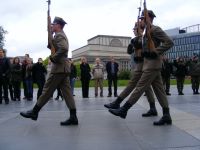 Germans, who had little love for the Poles; many of the extermination camps were in Poland (e.g., Auschwitz). What I’m building up to are the two great uprisings that destroyed 85 percent of the city and probably that many inhabitants. In 1943, an uprising in the ghetto by the desperate remaining Jews (at one time, over 300,000; today 1,000 and one synagogue) led to the total destruction of that section of the city. It’s not been rebuilt, but a major museum will open in 2012; we saw a monument where German Chancellor Willy Brandt in 1970 got down on his knees and repented the role of Germany in the extermination of the Jews (and gypsies and Poles). In 1944, in anticipation of a Soviet liberation of the city (and somewhat fearful that the Russians would put a puppet government in place), the government-in-exile ordered partisan troops to liberate the city in conjunction with the expected Russian arrival. To the great dismay of the partisans, the Russians sat on the opposite bank of the Vistula River and watched the carnage (and refused to let Allied planes land in Russian airports, which minimized resupply and logistical support); 63 days later, Hitler was so enraged that he ordered the city razed, and when the Russians did move into the city, not much was left.
Germans, who had little love for the Poles; many of the extermination camps were in Poland (e.g., Auschwitz). What I’m building up to are the two great uprisings that destroyed 85 percent of the city and probably that many inhabitants. In 1943, an uprising in the ghetto by the desperate remaining Jews (at one time, over 300,000; today 1,000 and one synagogue) led to the total destruction of that section of the city. It’s not been rebuilt, but a major museum will open in 2012; we saw a monument where German Chancellor Willy Brandt in 1970 got down on his knees and repented the role of Germany in the extermination of the Jews (and gypsies and Poles). In 1944, in anticipation of a Soviet liberation of the city (and somewhat fearful that the Russians would put a puppet government in place), the government-in-exile ordered partisan troops to liberate the city in conjunction with the expected Russian arrival. To the great dismay of the partisans, the Russians sat on the opposite bank of the Vistula River and watched the carnage (and refused to let Allied planes land in Russian airports, which minimized resupply and logistical support); 63 days later, Hitler was so enraged that he ordered the city razed, and when the Russians did move into the city, not much was left.
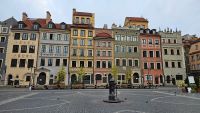 As I said, you’d never know it, because there’s
As I said, you’d never know it, because there’s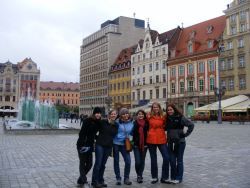 been a painstaking restoration of the old town, and it looks, well, old. Many of the churches were spared during the war (somehow), but they frequently did non-church use during the Soviet occupation. The old town (and the newer town) look like the pictures from the period of the 1780s, which is when I think the restorers were aiming. We’ve visited restored palaces, city gates, town squares, town halls, etc.–and they do pass for the 1780s, at least to us tourists.
been a painstaking restoration of the old town, and it looks, well, old. Many of the churches were spared during the war (somehow), but they frequently did non-church use during the Soviet occupation. The old town (and the newer town) look like the pictures from the period of the 1780s, which is when I think the restorers were aiming. We’ve visited restored palaces, city gates, town squares, town halls, etc.–and they do pass for the 1780s, at least to us tourists.
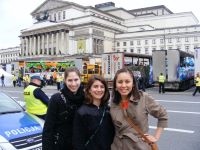 When we waited for our bus at 1:30, there was the beginning of a student equivalent of a bar crawl. Sascha said it’s something like in Berlin (his favorite city, I think), where the night clubs sponsor a parade, giving a float to each university, which wends its way through the streets, attracting crowds who dance; I put ours on a short lease, though, since we had an afternoon partly scheduled to see the Chopin statue and a famous former royal park, and partly for free time with a ride back guaranteed to the hotel.
When we waited for our bus at 1:30, there was the beginning of a student equivalent of a bar crawl. Sascha said it’s something like in Berlin (his favorite city, I think), where the night clubs sponsor a parade, giving a float to each university, which wends its way through the streets, attracting crowds who dance; I put ours on a short lease, though, since we had an afternoon partly scheduled to see the Chopin statue and a famous former royal park, and partly for free time with a ride back guaranteed to the hotel. 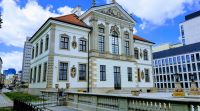 I spent the free time at the Chopin museum, since it’s the composer’s 200th birthday. Like many Russian empire intellectuals, Chopin left Warsaw at age 20 for Paris, and never returned, but the Poles celebrate him as one of their own; as German troops invaded in 1939, I
I spent the free time at the Chopin museum, since it’s the composer’s 200th birthday. Like many Russian empire intellectuals, Chopin left Warsaw at age 20 for Paris, and never returned, but the Poles celebrate him as one of their own; as German troops invaded in 1939, I 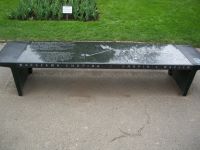 believe Polish radio played a Chopin Polonaise. I also like European museums because they have a “reduced rate” for seniors, which is how I think it should be!
believe Polish radio played a Chopin Polonaise. I also like European museums because they have a “reduced rate” for seniors, which is how I think it should be!
Tonight is “Night at the Museum,” when the museums are open late (till 3 a.m.) and free. They have special programs, including opening parts of the museum that are usually off limits. Several of us are planning to attend a Chopin concert at 11 p.m. in one of the Palaces, which should make our 8:30 start for Krakow seem even earlier.
Now if only I could find the photo shop where my grandfather had his picture taken.